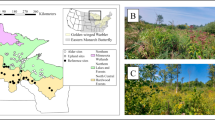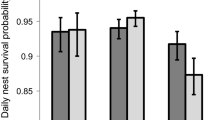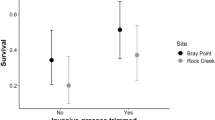Abstract
Pyrethroid insecticides containing deltamethrin provide broad spectrum insect control that can adversely affect food supplies of insectivorous birds. I hypothesized that this could result in lowered nest survival for a ground-nesting insectivorous bird, the Mountain Plover (Charadrius montanus), which preferentially nests on prairie dog colonies. I studied Mountain Plover nest survival in 2003–2010 at a small cluster of black-tailed prairie dog (Cynomys ludovicianus) colonies in north-central Montana. Three colonies were treated with deltamethrin to control fleas and limit the spread of plague; four untreated colonies served as controls. I monitored 412 plover nests during the 8 year study (264 on treatment colonies and 148 on control colonies) and found a strong negative effect of deltamethrin treatments on nest survival (βDust = −1.24, 95 % CI was −2.00 to −0.48) in the years following the actual treatment (2004–2006). I conclude that the observed treatment effect most likely occurred because of changes in insect (food) availability for the plover, and this in turn lowered nest survival because adults spent more time off nests or switched to less desirable insect prey. These results lend support to the need to consider the indirect effects of insecticide treatments on non-target species and suggest a potential conflict in current plague management strategies for prairie dogs.



Similar content being viewed by others
References
Akaike H (1973) Information theory and an extension of the maximum likelihood principle. In: Petran BN, Csaki F (eds) Second international symposium on information theory. Akademiai Kiado, Budapest, pp 267–281
Augustine DJ, Dinsmore SJ, Wunder MB, Dreitz VJ, Knopf FL (2008a) Plovers, prairie dogs and plague: response of a declining grassland bird to black-tailed prairie dog colony dynamics in landscapes affected by plague. Landsc Ecol 23:689–697
Augustine DJ, Matchett MR, Toombs TP, Cully JF Jr, Johnson TL, Sidle JG (2008b) Spatiotemporal dynamics of black-tailed prairie dog colonies affected by plague. Landsc Ecol 23:255–267
Baldwin, PH (1971) Diet of the Mountain Plover at the Pawnee National Grassland, 1970–71. U.S. Int Biol Program, Grassland Biome progress report, Colorado
Barnes AM (1982) Surveillance and control of plague in the United States. In: Edwards MA, McDonnell U (eds) Animal disease in relation to animal conservation. Academic Press, New York, pp 237–270
Barnes AM (1993) A review of plague and its relevance to prairie dog populations and the black-footed ferret. In: Oldemeyer, JL, DE Biggins, BJ Miller, R Crete (eds). Management of prairie dog complexes for the reintroduction of the black-footed ferret. U.S. Fish and Wildlife Service Biological Report, vol 13, pp 28–37
Barnes AM, Ogden LJ, Campos EG (1972) Control of the plague vector, Opisocrostis hirsutus, by treatment of prairie dog (Cynomys ludovicianus) burrows with 2% Carbaryl dust. J Med Entomol 9:330–333
Beard ML, Rose ST, Barnes A, Montenieri J (1992) Control of Oropsylla hirsuta, a plague vector, by treatment of prairie dog burrows with 0.5 % permethrin dust. J Med Entomol 29:25–29
Biggins DE, Kosoy MY (2001) Influences of introduced plague on North American mammals: implications from ecology of plague in Asia. J Mammal 82:906–916
Biggins DE, DiTomaso L, Godbey JL (2003) Abundance and diversity of arthropods on prairie dog colonies treated with deltamethrin to control fleas (Siphonaptera). USGS final report, Fort Collins
Biggins DE, Godbey JL, Gage KL, Carter LG, Montenieri JA (2010) Vector control improves survival of three species of prairie dogs (Cynomys) in areas considered enzootic for plague. Vector Borne Zoonotic Dis 10:17–26
Brown S, Hickey C, Harrington B, Gill R (2001) The U.S. shorebird conservation plan. 2nd edition. Manomet Center for Conservation Sciences, Massachusetts
Burnham KP, Anderson DR (2002) Model selection and multimodel inference: a practical information-theoretic approach. Springer, New York
Campbell TM, Clark TW, Richardson L, Forrest SC, Houston BR (1987) Food habits of Wyoming Black-footed Ferrets. American Midl Nat 117:208–210
Childers TM, Dinsmore SJ (2008) Density and abundance of Mountain Plovers in northeastern Montana. Wilson J Ornithol 120:700–707
Collinge SK, Johnson WC, Ray C, Matchett R, Grensten J, Cully JF Jr, Gage KL, Kosoy MY, Loye JE, Martin AP (2005) Landscape structure and plague occurrence in black-tailed prairie dogs on grasslands of the western USA. Landsc Ecol 20:941–955
Cooper RJ, Dodge KM, Martinat PJ, Donahoe SB, Whitmore RC (1990) Effects of diflubenzuron application on eastern deciduous forest birds. J Wildl Manage 54:486–493
Cully JF Jr (1997) Growth and life history changes in Gunnison’s prairie dogs after a plague epizootic. J Mammal 78:146–157
Cully JF Jr, Williams ES (2001) Interspecific comparisons of sylvatic plague in prairie dogs. J Mammal 82:894–905
Dinsmore SJ (2000) Mountain Plover. In: Reading RP, Miller B (eds) Endangered animals: a reference guide to conflicting issues. Greenwood Press, Westport, pp 213–218
Dinsmore SJ, Smith MD (2010) Mountain Plover responses to plague in Montana. Vector Borne Zoonotic Dis 10:37–45
Dinsmore SJ, White GC, Knopf FL (2002) Advanced techniques for modeling avian nest survival. Ecology 83:3476–3488
Dinsmore SJ, White GC, Knopf FL (2005) Mountain Plover population responses to black-tailed prairie dogs in Montana. J Wildl Manage 69:1546–1553
Douthwaite RJ (1995) Occurrence and consequences of DDT residues in woodland birds following tsetse fly spray operations in NW Zimbabwe. J Appl Ecol 32:727–738
Elliot M, Janes NF, Potter C (1978) The future of pyrethroids in insect control. Annu Rev Entomol 23:443–469
Extoxnet (1995) Deltamethrin. http://pmep.cce.cornell.edu/profiles/extoxnet/carbaryl-dicrotophos/deltamethrin-ext.html. Accessed 14 February 2012
Gage KL, Kosoy MY (2005) Natural history of plague: perspectives from more than a century of research. Annu Rev Entomol 50:505–528
Graul WD (1975) Breeding biology of the Mountain Plover. Wilson Bull. 87:6–31
Hinkle NC, Rust MK, Reierson DA (1997) Biorational approaches to flea (Siphonoptera: pulicidae) suppression: present and future. J Agric Entomol 14:309–321
Holmes SB (1998) Reproductive and nest behaviors of Tennessee warblers (Vermivora peregrine) in forests treated with Lepidoptera-specific insecticides. J Appl Ecol 35:185–194
Hudson RH, Tucker RK, Haegele MA (1984) Handbook of toxicity of pesticides to wildlife, 2nd edn. U.S. Fish and Wildlife Service, Washington, DC
Hunter ML, Witham JW, Dow H (1984) Effects of carbaryl induced depression in invertebrate abundance on the growth and behavior of American black duck and mallard ducklings. Can J Zool 62:452–456
Karhu RR (1999) Field trials of technical pyriproxyfen (Nylar) and Pyraperm in black-tailed prairie dog (Cynomys ludovicianus) towns on the Rocky Mountain Arsenal National Wildlife Refuge, Colorado. MS thesis, University of Wyoming, Laramie
Karhu RR, Anderson SH (2000) Effects of pyriproxyfen spray, powder, and oral bait treatments on the relative abundance of non-target arthropods of black-tailed prairie dog (Rodentia: Sciuridae) towns. J Med Entomol 37:612–618
Knopf FL (1998) Food habits of Mountain Plovers wintering in California. Condor 100:382–384
Knopf FL, Wunder MB (2006) Mountain Plover (Charadrius montanus). In: Poole A (ed) The Birds of North America. The Academy of Natural Sciences, Philadelphia, p 211
Knowles CJ, Knowles PR (1984) Additional records of Mountain Plovers using prairie dog towns in Montana. Prairie Nat 16:183–186
Knowles CJ, Stoner CJ, Gieb SP (1982) Selective use of black-tailed prairie dog towns by Mountain Plovers. Condor 84:71–74
Kotliar NB (2000) Application of the new keystone-species concept to prairie dogs: how well does it work? Conserv Biol 14:1715–1721
Martin PA, Johnson DL, Forsyth DL, Hill BD (1998) Indirect effects of the pyrethroid insecticide deltamethrin on reproductive success of Chestnut-collared Longspurs. Ecotoxicology 7:89–97
Martin PA, Johnson DL, Forsyth DJ, Hill BD (2000) Effects of two grasshopper control insecticides on food resources and reproductive success of two species of grassland songbirds. Environ Toxicol Chem 19:2987–2996
Matchett MR, Biggins DE, Carlson V, Powell B, Rocke T (2010) Enzootic plague reduces black-footed ferret (Mustela nigripes) survival in Montana. Vector Borne Zoonotic Dis 10:27–35
Miller BJ, Reading RP, Biggins DE, Detling JK, Forrest SC, Hoogland JL, Javersak J, Miller SD, Proctor J, Truett J, Uresk JW (2007) Prairie dogs: an ecological review and current biopolitics. J Wildl Manage 71:2801–2810
Moreby SJ, Southway S, Barker A, Holland JM (2001) A comparison of the effect of new and established pesticides on nontarget invertebrates of winter wheat fields. Environ Toxicol Chem 20:2243–2254
Olson SL, Edge D (1985) Nest site selection by Mountain Plovers in northcentral Montana. J Range Manage 38:280–282
Pascual JA, Peris SJ (1992) Effects of forest spraying with two application rates of cypermethrin on food supply and breeding success of the blue tit (Parus caeruleus). Environ Toxicol Chem 11:1271–1280
Pendleton FN, Baldwin AH (2007) The effects of spraying deltamethrin for tsetse fly control on insectivorous bird populations in the Okavango Delta, Botswana. African J Ecol 45:566–576
Perry AS, Yamamoto I, Ishaaya I, Perry RY (1998) Insecticides in agriculture and the environment. Springer, Berlin
Rands MRW (1985) Pesticide use on cereals and the survival of grey partridge chicks: a field experiment. J Appl Ecol 2:49–54
Sample BE, Cooper RJ, Whitmore RC (1993) Dietary shifts among song birds from a diflubenzuron-treated forest. Condor 95:616–624
Sargeant AB, Sovada MA, Greenwood RJ (1987) Responses of three prairie ground squirrel species, Spermophilus franklinii, S. richardsonii, and S. tridecemlineatus, to duck eggs. Can Field-Nat 101:95–97
Seery DB, Biggins DE, Montenieri JA, Enscore RE, Tanda DL, Gage KL (2003) Treatment of black-tailed prairie dog burrows with deltamethrin to control fleas (Insecta: Siphonaptera) and plague. J Med Entomol 40:718–722
Skrade PDB, Dinsmore SJ (2010) Sex-related dispersal in the Mountain Plover (Charadrius montanus). Auk 127:671–677
Skrade PDB, Dinsmore SJ (2012) Incubation patterns of a shorebird with rapid multiple clutches, the Mountain Plover (Charadrius montanus). Can J Zool 90:257–266
Stapp P (1998) A reevaluation of the role of prairie dogs in Great Plains grasslands. Conservation Biol 12:1253–1259
Summers A, Linder RL (1978) Food habits of the black-tailed prairie dog in western South Dakota. J Range Manage 31:134–136
U.S. Department of the Interior (2010) Endangered and threatened wildlife and plants: listing the Mountain Plover as threatened. Fed Reg 75:37353–37358
U.S. Department of the Interior (2011) Endangered and threatened wildlife and plants: withdrawal of the proposed rule to list the Mountain Plover as Threatened. Fed Reg 76:27756–27799
Uresk DW (1984) Black-tailed prairie dog food habits and forage relationships in western South Dakota. J Range Manage 37:325–329
Westerskov K (1950) Methods for determining the age of game bird eggs. J Wildl Manage 14:56–67
White GC, Burnham KP (1999) Program MARK: survival estimation from populations of marked animals. Bird Study 46:120–139
Whitmore RC, Cooper RJ, Sample BE (1993) Bird fat reductions in forests treated with Dimilin. Environ Toxicol Chem 12:2059–2064
Acknowledgments
I thank Iowa State University (Department of Natural Resource Ecology and Management), the U.S. Bureau of Land Management (Malta Field Office, Montana; annual Challenge Cost Share Grants in 2003–2006), Montana Fish, Wildlife and Parks (Cooperative Agreement in 2006), U.S. Fish and Wildlife Service (Neotropical Migratory Bird Conservation Act Grant #4112), and the World Wildlife Fund (Grant number 3252) for financial support. TM Childers, JJ Grensten, PDB Skrade, and CT Wilcox assisted with fieldwork. I thank FL Knopf, MR Matchett, and two anonymous reviewers for their comments on this manuscript.
Ethical standards
All work conducted as part of this study was approved by the Iowa State University Institutional Animal Care and Use Committee (Protocol #5-06-6129-Q).
Conflict of interest
The author declares that he has no conflict of interest.
Author information
Authors and Affiliations
Corresponding author
Rights and permissions
About this article
Cite this article
Dinsmore, S.J. Mountain Plover responses to deltamethrin treatments on prairie dog colonies in Montana. Ecotoxicology 22, 415–424 (2013). https://doi.org/10.1007/s10646-012-1035-8
Accepted:
Published:
Issue Date:
DOI: https://doi.org/10.1007/s10646-012-1035-8




